
E-BOOK:THE KEPT TRUTH
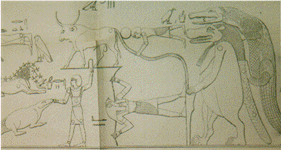 Magic Square: Rotas Opera tenet Arepo Sator, reveled the enigma of the Magic square.
Egypth, Imperial Rome, Crusades, Templars... An interesting and original
work that put on discussion the Darwin evolutionistic theory's.
Magic Square: Rotas Opera tenet Arepo Sator, reveled the enigma of the Magic square.
Egypth, Imperial Rome, Crusades, Templars... An interesting and original
work that put on discussion the Darwin evolutionistic theory's.
The Magic Square, this is the name with which it's known, is a palindrome
formed by five words of five letters that can be read in the same way
from four directions of the side of the square itself.
This formula (ROTAS OPERA TENET AREPO SATOR) was very widespread in the
places of the Roman Empire, probably propagandised by the legionaries
of garrison. In 1937 it was found five times in Mesopotamia and there
are some specimens of it in Egypt, in Cappadocia, in Britain and in Hungary.
There are most recent specimens, I refer to the ones aren't proper to
the epoch of the Roman Empire, but it's necessary to make a reference
to Middle Ages and especially to the sacred buildings which are attributed
to the Order of the Templars and to buildings which are connected to them.
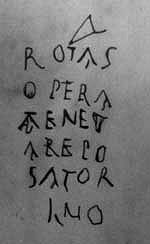 The most ancient and easy datable specimens, with reference to the period,
were found in Pompeii, that was buried by the eruption of Vesuvius at
79 A. C., and so they certainly belong to a former period of the eruption.
The two Pompeian evidences have been very important for the development
of this search because it wouldn't have the foundations to support two
thousands years of history without the information obtained from them.
The most ancient and easy datable specimens, with reference to the period,
were found in Pompeii, that was buried by the eruption of Vesuvius at
79 A. C., and so they certainly belong to a former period of the eruption.
The two Pompeian evidences have been very important for the development
of this search because it wouldn't have the foundations to support two
thousands years of history without the information obtained from them.
About the two Pompeian evidences, there is only a graphic reproduction
of the one found on a column of the Big Palestra; the other specimen of
the "Magic Square", that I will call "Sator", was found during the archaeological
excavations from 1925 to 1936 in Paquio Proculo's house, duumvir around
74 A. C.; scholar Della Corte found the two palindromes during the period
of the excavations of Pompeii.
I did a travel over the history, the mythology and the beliefs of the
ancient civilizations, reading the enigma in a particular way and taking
Pompeii as starting point and reference. Then I continued over Middle
Ages until arrive today , where the science, perhaps, could confirm an
incredible and extraordinary story.
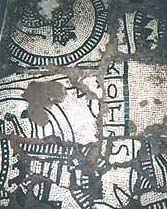 It will be a real discussion, based on questions, to which it will try
to give an answer. My interpretation of the "Sator" wants to be the reinforcement,
that there isn't, and that makes to result beliefs and customs of ancient
times and of all the others as inexplicable and incomprehensible.
It will be a real discussion, based on questions, to which it will try
to give an answer. My interpretation of the "Sator" wants to be the reinforcement,
that there isn't, and that makes to result beliefs and customs of ancient
times and of all the others as inexplicable and incomprehensible.
It will be very interesting to know that this formula is very widespread.
Europe, especially Italy and France, has numerous specimens that it's
possible to see in the original square formula or in a classical text
or making up a circle.
About my solution it will be necessary to make a reference to the classical
arrangement, that is the square one.
I devoted a particular interest to the religious belief of the ancient
civilizations interpreting, always with a subjective and original way,
some works of art. Very interesting are some Pompeian paintings which
I connected to the representations of the ceilings of the great Pharaoh's
tombs.
The big buildings of the cathedrals, attributed to the period of the crusades
and so of the Templars, will find also them an interesting reference to
ancient Egypt, as far as arrive to the Plain of Giza.
Then the Charterhouse of Trisulti , with the enigmatic paintings of Neapolitan
painter Filippo Balbi, will be, I like to define it so, a kind of "out
the nines" of the information coming out of the "Sator".
ENIGMA'S SOLUTION
In Pompeii, before the eruption of 79 A. C., was spoken and written a
vulgar Latin, foundation of the Romance languages.
It needs to make a reference to this language to arriving at the solution
of the enigma that the "Sator" contains, because the indication of the
reading key is in this language and some words of the solution belong
to it.
The vulgar Latin wasn't only a language spoken by the lowest classes of
the population, but it was the language spoken by all the people, with
shades according to the place of origin and to the social class of belonging.
As it knows the specimen of "Sator" found in Pompeii, has above itself
a triangle and has under itself the writing "ANO". This geometric figure
and this short word are the key to "unhinge" the hidden secret of the
enigma.
The word "ANO" means ring (from classical Latin ANUS, ANUM); the ring
to take into consideration is the ring that contains the triangle.
The ring par excellence corresponds to the figure; it's the Signed-Ring
of Solomon, that he received by his father David, from whom derives the
name of the symbol that is obtained by the union of two triangles: the
star of David or Hexagram.
It's the key that shows the way, the way to reading that it's necessary
to do through the letters contained in the square.
Superimposing the star upon the "Sator" it's observed that these two figures
are complementary:
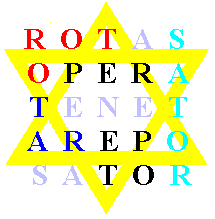
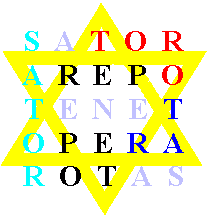
Starting from the point turned to the top and going on the left, a determinate
tracing is obtained, through that it goes just once on every segment (it's
the only way that originates a translatable phrase). The word "AENEAS" is
obtained by the letters that are out of that determinate tracing. Reading
the letters on that determinate tracing the following phrase is obtained
(colours show the following course):
TORO TRA
PER SATOR PETO
AENEAS.
THE BULL IS TRANSFORMED THROUGH THE CREATOR INTO THE MAN.
It's evident that "AENEAS" means man, because the composition of the "Sator"
is to attributed to the Romans.
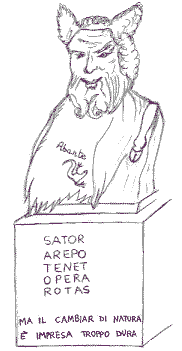 THE SATOR OF PAINTER FILIPPO BALBI
THE SATOR OF PAINTER FILIPPO BALBI
In the Charterhouse of Trisulti is present a painting of Neapolitan painter
Filippo Balbi, made around 1860 and in which the "Sator" is contained.
Observing the picture it's possible to notice a mythological personage
(Abante) with clear taurine features and a writing under the "Sator":
"MA IL CAMBIAR DI NATURA E' IMPRESA TROPPO DURA" (BUT TO CHANGE NATURE
IS A VERY HARD UNDERTAKING).
|